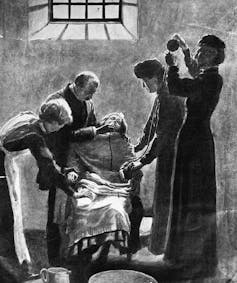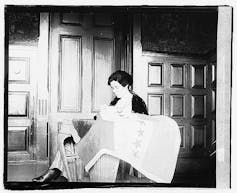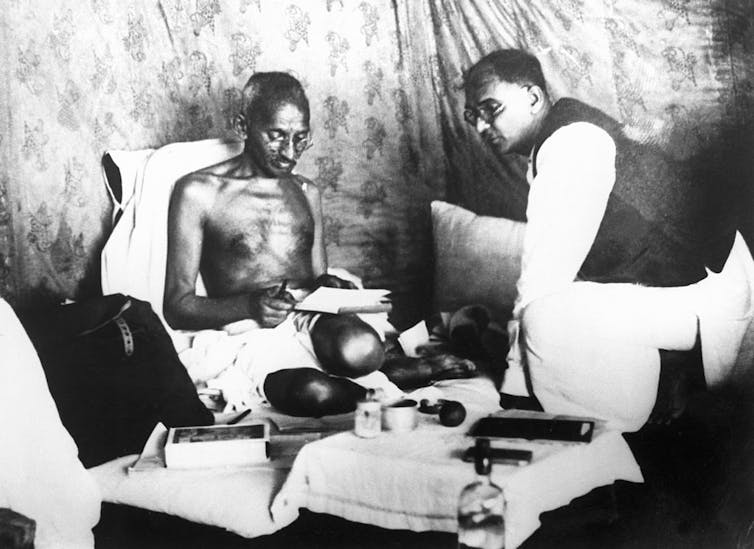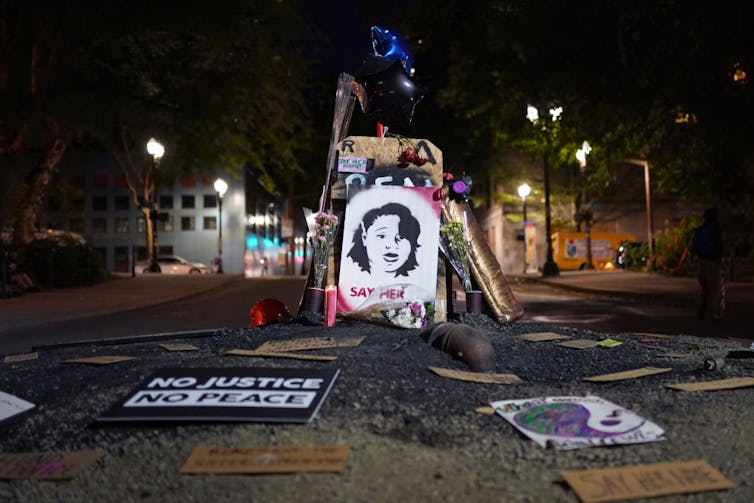Suffragists used hunger strikes as a powerful tool of resistance – a tactic still employed by protesters 100 years on
- Written by Victoria W. Wolcott, Professor of History, University at Buffalo, The State University of New York
Asylum seekers held in detention by Immigration and Customs Enforcement in California have launched a series of hunger strikes[1] to demand personal protective equipment[2], medical care and provisional release as COVID-19 cases surge among incarcerated populations.
In Kentucky, four activists went on a 25-day hunger strike[3] seeking justice for Breonna Taylor[4], the African American woman police officers killed in her home in March 2020.
As Americans celebrate the 100th anniversary of the 19th Amendment, which granted women the right to vote in August 1920[5], these protesters and many others owe a debt of gratitude to the militant suffragists who elevated the hunger strike as a powerful form of protest.
The hunger strike
The prison system, as it developed in the second half of the 19th century[6], rendered prisoners largely invisible to the outside world.
Imprisoned hunger strikers and their supporters outside the prison gates made visible what was invisible. As a historian[7] of American social movements, I have studied the origins of this tactic.
Although there were earlier examples of hunger strikes in early modern Europe and Russia, Marion Dunlop, a British suffragist, carried out the first modern-day hunger strike in 1909 in London’s Holloway Prison[8].
In both Great Britain and North America, the immediate motivation for suffragists to embark on hunger strikes was the demand to be considered a political prisoner. Political prisoners had more rights than other prisoners and were not considered merely criminals[9].
 An illustration showing prison wardens force-feeding a hunger striking suffragette in Holloway Prison. Photo by © Hulton-Deutsch Collection/CORBIS/Corbis via Getty Images[10]
An illustration showing prison wardens force-feeding a hunger striking suffragette in Holloway Prison. Photo by © Hulton-Deutsch Collection/CORBIS/Corbis via Getty Images[10]
Dunlop and other suffragists sought public sympathy when they refused to eat, playing on popular ideas that white female bodies were vulnerable and passive. Hunger strikers made their starving bodies a form of speech that could breach prison walls[11] through testimonials, picketing and protests.
That sympathy increased when suffragists like Dunlop were routinely subjected to brutal force-feedings. Initially devised to feed patients in asylums, force-feeding often damaged suffragists’ teeth, gums and throat. In some cases, when food went into lungs, it even resulted in pneumonia[12].
One suffragist, Mary Leigh[13], who was forcibly fed in 1909 after her arrest protesting for women’s suffrage, recalled the horror of the experience. She wrote[14]: “The sensation is most painful – the drums of the ear seem to be bursting, a horrible pain in the throat and the breast. The tube is pushed down 20 inches … I resist and am overcome.”
Suffragists argued that their rough handling and force-feeding revealed the brutality of the government. After their release, Dunlop, Leigh and others wrote prison narratives and spoke at rallies to encourage other women to follow their example[15] and join the movement.
American suffragists
 Suffragist Alice Paul. Library of Congress Prints and Photographs Division Washington, D.C. 20540[16]
Suffragist Alice Paul. Library of Congress Prints and Photographs Division Washington, D.C. 20540[16]
These narratives soon reached American ears, and by the 1910s some American suffragists adopted the more militant British tactics[17], rather than the lobbying and polite protests of earlier decades. They were led by Alice Paul[18], the author of the Equal Rights Amendment, who had spent time in England learning from her British counterparts[19].
When arrested for offenses such as obstructing traffic during demonstrations or chaining themselves to the White House fence, suffragists began their own hunger strikes. They too were forcibly fed[20].
Perhaps the most spectacular attempt to bring publicity to the hunger strikers was undertaken by American journalist Djuna Barnes[21]. In 1914 Barnes staged a forcible feeding to demonstrate the brutality of the process. The staged event was covered by New York World Magazine and both horrified and fascinated readers.
Photographs of her experience appeared beside her article[22] in which she stated that she “shared the greatest experience of the bravest of my sex.”
This form of performative journalism brought the spectacle of physical punishment outside the prison walls to the American public.
International repercussions
Suffragists directly influenced the use of the hunger strike by British colonial subjects in Ireland and India. When Marion Dunlop was released from prison after her hunger strike in 1909, she gave a public speech[23] attended by a visiting Indian lawyer, Mohandas Karamchand Gandhi.
Male Irish Republicans employed hunger strikes after the 1916 Easter Rising[24] against British rule – some four years after female suffragists in the country employed the same tactic. The Republican men, however, did not acknowledge the precedent set by women[25].
 Gandhi on hunger strike in 1933. Photo by Keystone-France/Gamma-Keystone via Getty Images[26]
Gandhi on hunger strike in 1933. Photo by Keystone-France/Gamma-Keystone via Getty Images[26]
In the West, Gandhi’s emaciated and frail body came to symbolize the spectacle of a colonized India seeking its freedom through nonviolence[27]. In the United States, civil rights activists like Bayard Rustin[28] began using Gandhi’s tactic of nonviolent direct action by the early 1940s.
During World War II, Rustin and other male pacifists served in Civilian Public Service camps, which offered an alternative to military service, or, in some cases, in prison. Imprisoned pacifists launched hunger strikes[29] to protest racial segregation and mistreatment. Many of the pacifists suffered painful force-feeding by prison authorities[30].
Pacifism and hunger strike
While during the war years male pacifists took center stage, at the war’s end Black and white women began to actively engage in nonviolent direct action. Radical pacifist women routinely used hunger strikes[31] as a form of protest.
An African American women, Eroseanna Robinson, exemplifies this trend. She was a member of the Peacemakers, a radical pacifist organization that practiced civil disobedience and tax refusal and took to hunger strikes when in jail[32].
[Deep knowledge, daily. Sign up for The Conversation’s newsletter[33].]
In 1960, when Robinson was arrested for not paying her taxes, she practiced total noncompliance and refused to submit to what she perceived as undemocratic and coercive power. During her year of imprisonment, Robinson refused all nourishment and suffered painful force-feedings[34].
Robinson’s ability to control her own body through self-discipline gave her the strength she needed to endure months of fasting and force-feeding. And as in the case of the suffragists, Robinson’s defiance revealed the brutality of the state[35].
 A memorial to Breonna Taylor in Portland, Oregon. In Kentucky, four activists went on a hunger strike. Photo by Nathan Howard/Getty Images[36]
A memorial to Breonna Taylor in Portland, Oregon. In Kentucky, four activists went on a hunger strike. Photo by Nathan Howard/Getty Images[36]
Pacifists and civil rights activists who engaged in hunger strikes were directly indebted to the suffragists who had preceded them. These activists used their bodies to subvert the prison system.
Today, prisoners and those fighting for racial justice are attempting much the same to bring attention and a measure of justice to the suffering world.
References
- ^ hunger strikes (www.democracynow.org)
- ^ personal protective equipment (www.cdc.gov)
- ^ hunger strike (www.courier-journal.com)
- ^ seeking justice for Breonna Taylor (www.facebook.com)
- ^ August 1920 (museum.archives.gov)
- ^ 19th century (www.penguinrandomhouse.com)
- ^ historian (arts-sciences.buffalo.edu)
- ^ Holloway Prison (global.oup.com)
- ^ merely criminals (www.palgrave.com)
- ^ Photo by © Hulton-Deutsch Collection/CORBIS/Corbis via Getty Images (www.gettyimages.com)
- ^ prison walls (broadviewpress.com)
- ^ resulted in pneumonia (www.tandfonline.com)
- ^ Mary Leigh (www.palgrave.com)
- ^ wrote (www.palgrave.com)
- ^ example (books.google.com)
- ^ Library of Congress Prints and Photographs Division Washington, D.C. 20540 (cdn.loc.gov)
- ^ British tactics (yalebooks.yale.edu)
- ^ Alice Paul (www.womenshistory.org)
- ^ British counterparts (books.google.com)
- ^ forcibly fed (www.blackdogandleventhal.com)
- ^ Djuna Barnes (www.britannica.com)
- ^ her article (digital.lib.umd.edu)
- ^ public speech (www.taylorfrancis.com)
- ^ 1916 Easter Rising (www.history.com)
- ^ precedent set by women (www.hup.harvard.edu)
- ^ Photo by Keystone-France/Gamma-Keystone via Getty Images (www.gettyimages.com)
- ^ nonviolence (www.upenn.edu)
- ^ Bayard Rustin (kinginstitute.stanford.edu)
- ^ hunger strikes (www.kentstateuniversitypress.com)
- ^ prison authorities (books.google.com)
- ^ hunger strikes (www.upenn.edu)
- ^ jail (uncpress.org)
- ^ Sign up for The Conversation’s newsletter (theconversation.com)
- ^ painful force-feedings (books.google.com)
- ^ state (www.swarthmore.edu)
- ^ Photo by Nathan Howard/Getty Images (www.gettyimages.com)
Authors: Victoria W. Wolcott, Professor of History, University at Buffalo, The State University of New York

